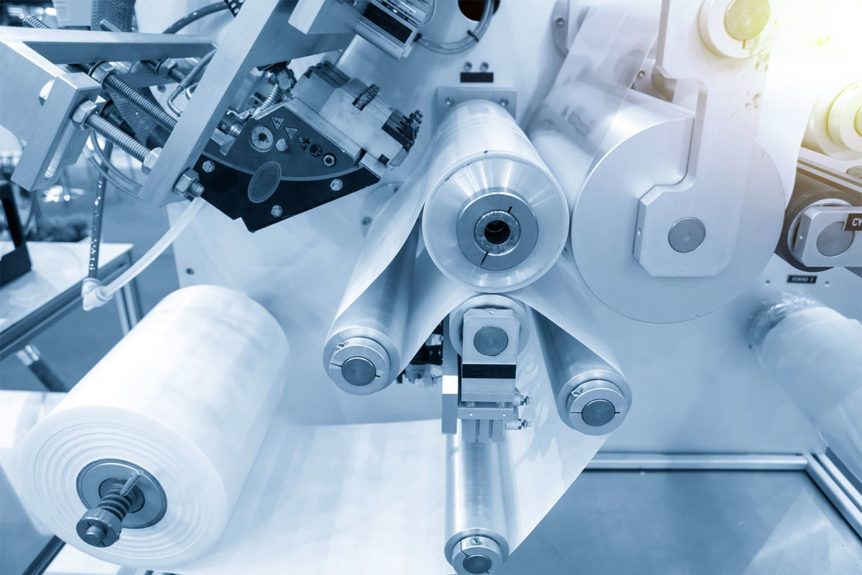This post is intended to provide a very basic overview of the roll coating process also commonly referred to as roll-to-roll coating. We welcome your feedback and hope this post has been helpful to you and your associates.
Roll-to-roll processing is a fabrication method used in manufacturing that embeds, coats, prints or laminates various fluid materials onto a flexible rolled substrate material as that material is fed continuously from one roller to another (unwind to rewind). The roll-to-roll technique typically consists of several rollers, known as the web path, which winds the substrate material over and through these rollers as it carries out a number of operations. The technique applies materials onto the substrate as it moves along the web to create or produce a product or part.
To go a bit deeper, roll coating involves a pre-metered coating and uses a series of rollers to meter and apply coating liquid onto a substrate. A metered film of coating liquid is first formed on the roller surface before it is applied to the substrate, so the amount of coating material delivered to the substrate is nearly independent of the fabric properties and structures. Mostly determined by the type of the fluid, the type of applicator roller and the relative speed of two rotation surfaces, precise control is possible. Varying substrate thickness does not result in uneven coating thickness.
Single Rotating Roller
The simplest roll coating set-up uses a single rotating roller. The bottom half of the roller is immersed in a coating liquid bath and the upper part of the roller is in contact with the fabric substrate. As it rotates, the coating liquid forms a film on the roller surface and part of the liquid film is transferred from the roller surface to a fabric substrate. The amount of coating on the substrate is governed by hydrodynamics. The rotation speed of the roller, the substrate speed, and rheological properties of coating fluid (surface tension, viscosity, and density) are factors determining coating thickness. In this set-up, one roller is a metering device as well as an application device. More precise control is achieved by the addition of more rollers.
Three-roll Coating
Three-roll coating uses a metering roller, an applicator roller and a backup roller. Common three-roll configurations are nip feed coating and L-head coating. In three-roll nip feed coating, the nip formed by a metering roller and an applicator roller is flooded with coating liquid and functions as a reservoir. The applicator roller picks up the coating liquid from the nip and the amount of coating liquid delivered to the fabric substrate is metered by the metering roller rotating in a reverse direction to the applicator roller. After coating liquid transfers from the metering roller to the applicator roller, any coating liquid remaining on the metering roller surface is cleaned by a doctor blade, otherwise it will result in coating defects, such as streaks or film roughness. Film formed on the applicator roller is deposited onto the surface substrate supported by a back-up roller. This configuration needs only a minimal amount of coating fluid, but a drawback is possible coating fluid leakage. It can be problematic when coating liquid has low viscosity.
In three-roll pan feed or L-head coating, a liquid film is formed on the applicator roller rotating through the coating liquid, metered by a metering roller, and deposited on the substrate fabric on a back-up roller. To increase coating speed, one more roller – a pick-up roller running at a reduced speed – can be added, and this system is called a four-roll pan-fed coating system.
In reverse metering, the applicator and metering rollers rotate in opposite directions. When they rotate in the same direction, it is called forward metering. Reverse metering produces a smoother film with better stability, while forward roll metering is prone to generate unstable, non-uniform films. Therefore reverse roll coating is more commonly used.
Roll coating uses water-based solutions, solvent-based coating materials as well as hot melts. In hot melt roller coating, solid pellet is melted between the heated melt rollers, forming a melt film and deposited on a substrate. The substrate fabric is usually preheated before hot melt is applied
Web Tension Control in Roll-to-Roll Systems
The effectiveness of roll-to-roll processing relies on the precision of web tension control. Tension control of the substrate web as it moves from roll-to-roll is critical to production. R2R processing must remain constant and uniform throughout the process. Any minor variation in tension could destabilize the material applied to the substrate, rendering the register or product unusable.
Roll-to-Roll Applications & Industries
R2R processing is utilized in numerous manufacturing and industrial sectors – IT, electronics and computing, energy, textiles, medical, metal fabrication, and biosciences, to name a few. Many applications require flexible material for completing a finished product. From electronic devices, solar panels, thin-film batteries to fuel cell membranes, coating textiles with agents, and medical or scientific devices – are all produced through roll-to-roll processing. For example, in the production of large-area electronic devices, flexible displays or circuit boards is achieved through R2R processing from rolls of plastic film or metal foil.
National Polymer is a leading R&D and manufacturing company specializing in formulation chemistry, pilot coating, coating technologies, deformulation, reformulation, batch optimization, and production. To learn more about our capabilities, call us today at (800) 679.0477.
And thank you for reading our blog.


